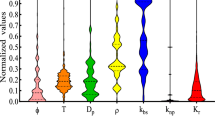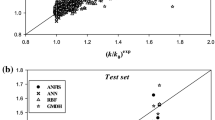Abstract
In current study, a flow boiling experimental examination has been performed on water, water-TiO2 nanofluid, and water-Al2O3 nanofluid and Gradient Boost Regression model was established to predict the Nusselt number of TiO2 and Al2O3 nanofluids. Nusselt number was calculated by varying heat flux, Reynolds number, and volumetric concentration. Good agreement was shown by water results acquired from experiments with the correlation of Chen and CFD. Results demonstrated that the Nusselt number of TiO2 and Al2O3 nanofluid was larger than water. Increment in Nusselt number was noticed with the increment in concentration, heat flux, and Reynolds number. It was seen that Al2O3 nanofluid was superior to TiO2 nanofluid. Highest improvement in the Nusselt number was 37% shown by Al2O3 nanofluid when compared to water. Correlations of Nusselt number were developed for both nanofluids. GBR-GSO machine learning model showed a good agreement with the experimental Nusselt number.






















Similar content being viewed by others
Abbreviations
- \({c}_{\rm l}\) :
-
Specific heat capacity of liquid, J Kg−1 K−1
- C:
-
Concentration
- \({D}_{\mathrm{h}}\) :
-
Hydraulic diameter of the tube, m
- F:
-
Two-phase multiplier
- h:
-
Heat transfer coefficient, Wm−2 K−1
- \({H}_{\mathrm{fg}}\) :
-
Enthalpy of vaporization, Jkg−1
- k:
-
Turbulent kinetic energy, m2s−2
- \({k}_{\mathrm{l}}\) :
-
Thermal conductivity of the liquid, Wm−1 K−1
- \(\dot{m}\) :
-
Mass flux, kgm−2 s−1
- m:
-
Nanoparticle mass, kg
- Nu:
-
Nusselt number
- Pr:
-
Prandtl number
- Q:
-
Heat, J
- q:
-
Heat flux, Wm−2
- R2 :
-
Coefficient of determination
- Re:
-
Reynolds number
- S:
-
Suppression factor
- Sq :
-
Use defined source term
- v:
-
Velocity, ms−1
- x:
-
Vapor quality
- Xtt :
-
Martinelli parameter
- CAD:
-
Computer-aided design
- CFD:
-
Computational fluid dynamics
- EG:
-
Ethylene glycol
- EPE:
-
Expanded poly ethylene
- GBR:
-
Gradient boost regressor
- GSO:
-
Grid search optimization
- HTC:
-
Heat transfer coefficient
- MWCNT:
-
Multi-walled carbon nano tube
- MAE:
-
Mean absolute error
- MSE:
-
Mean square error
- RANS:
-
Reynolds averaged navier–stokes
- RMSE:
-
Root mean square error
- RNG:
-
Re-normalisation group
- RPI:
-
Rensselaer polytechnic institute
- SS:
-
Stainless steel
- SST:
-
Shear stress transport
- UVM:
-
Ultrasonic vibration machine
- bf:
-
Base fluid
- C:
-
Convective
- cb:
-
Convective boiling
- E:
-
Evaporative
- FZ:
-
Forster-Zuber’s
- g:
-
Vapor phase
- l:
-
Liquid
- nb:
-
Nucleate boiling
- np:
-
Nanoparticle
- Q:
-
Quenching
- tp:
-
Two-phase
- \(\Delta P\) :
-
Difference in wall and saturation pressure, Pa
- \(\Delta T\) :
-
Difference in wall and saturation temperature, K
- \(\alpha\) :
-
Volume fraction
- \(\varepsilon\) :
-
Rate of dissipation of turbulent kinetic energy, m2s−3
- \(\mu\) :
-
Dynamic viscosity, kgm−1 s−1
- \(\nu\) :
-
Kinematic viscosity, m2 s−1
- \(\rho\) :
-
Density, kgm−3
- \(\sigma\) :
-
Surface tension, Nm−1
- \(\tau\) :
-
Stress–strain tensor
- \(\varnothing\) :
-
Nanofluid volumetric concentration
References
Choi S, Eastman J “Enhancing thermal conductivity of fluids with nanoparticles,” in Proceedings of the ASME international mechanical engineering congress and exposition. New York: ASME, 1995, pp. 99–106https://www.researchgate.net/publication/236353373
Karimzadehkhouei M, Sezen M, Şendur K, Pınar Mengüç M, Koşar A. Subcooled flow boiling heat transfer of γ-Al2O3/water nanofluids in horizontal microtubes and the effect of surface characteristics and nanoparticle deposition. Appl Therm Eng. 2017;127:536–46. https://doi.org/10.1016/j.applthermaleng.2017.08.041.
Morshed AKMM, Yang F, Ali YM, Khan JA, Li C. Enhanced flow boiling in a microchannel with integration of nanowires. Appl Therm Eng. 2011;32:68–75. https://doi.org/10.1016/j.applthermaleng.2011.08.031.
Sarwar MS, Jeong YH, Chang SH. Subcooled flow boiling CHF enhancement with porous surface coatings. Int J Heat Mass Transf. 2007;50(17–18):3649–57. https://doi.org/10.1016/j.ijheatmasstransfer.2006.09.011.
Abedini E, Zarei T, Afrand M, Wongwises S. Experimental study of transition flow from single phase to two phase flow boiling in nanofluids. J Mol Liq. 2017;231:11–9. https://doi.org/10.1016/j.molliq.2017.01.049.
Bai P, Tang T, Tang B. Enhanced flow boiling in parallel microchannels with metallic porous coating. Appl Therm Eng. 2013;58(1–2):291–7. https://doi.org/10.1016/j.applthermaleng.2013.04.067.
Suresh S, Selvakumar P, Chandrasekar M, Raman VS. Experimental studies on heat transfer and friction factor characteristics of Al2O3/water nanofluid under turbulent flow with spiraled rod inserts. Chem Eng Process Process Intensif. 2012;53:24–30. https://doi.org/10.1016/j.cep.2011.12.013.
Mohammed HA, Ali Abuobeida IAM, Vuthaluru HB, Liu S. “Two-phase forced convection of nanofluids flow in circular tubes using convergent and divergent conical rings inserts. Int Commun Heat Mass Transf. 2019;101:10–20. https://doi.org/10.1016/j.icheatmasstransfer.2018.12.010
Patra N, Ghosh P, Singh RS, Nayak A. Flow visualization in dilute oxide based nanofluid boiling. Int J Heat Mass Transf. 2019;135:331–44. https://doi.org/10.1016/j.ijheatmasstransfer.2019.01.145.
Paul G, Das PK, Manna I. Assessment of the process of boiling heat transfer during rewetting of a vertical tube bottom flooded by alumina nanofluid. Int J Heat Mass Transf. 2016;94:390–402. https://doi.org/10.1016/j.ijheatmasstransfer.2015.11.013.
Duangthongsuk W, Wongwises S. An experimental study on the heat transfer performance and pressure drop of TiO2-water nanofluids flowing under a turbulent flow regime. Int J Heat Mass Transf. 2010;53(1–3):334–44. https://doi.org/10.1016/j.ijheatmasstransfer.2009.09.024.
Qi C, Wan YL, Li CY, Han DT, Rao ZH. Experimental and numerical research on the flow and heat transfer characteristics of TiO2-water nanofluids in a corrugated tube. Int J Heat Mass Transf. 2017;115:1072–84. https://doi.org/10.1016/j.ijheatmasstransfer.2017.08.098.
Zhou J, et al. Saturated flow boiling heat transfer investigation for nanofluid in minichannel. Exp Therm Fluid Sci. 2017;85:189–200. https://doi.org/10.1016/j.expthermflusci.2017.03.002.
Sarafraz MM, Hormozi F. Scale formation and subcooled flow boiling heat transfer of CuO-water nanofluid inside the vertical annulus. Exp Therm Fluid Sci. 2014;52:205–14. https://doi.org/10.1016/j.expthermflusci.2013.09.012.
Sarafraz MM, Hormozi F. Comparatively experimental study on the boiling thermal performance of metal oxide and multi-walled carbon nanotube nanofluids. Powder Technol. 2016;287:412–30. https://doi.org/10.1016/j.powtec.2015.10.022.
Rana KB, Agrawal GD, Mathur J, Puli U. Measurement of void fraction in flow boiling of ZnO-water nanofluids using image processing technique. Nucl Eng Des. 2014;270:217–26. https://doi.org/10.1016/j.nucengdes.2014.01.008.
Nikkhah V, Sarafraz MM, Hormozi F. Application of spherical copper oxide (II) water nano-fluid as a potential coolant in a boiling annular heat exchanger. Chem Biochem Eng Q. 2015;29(3):405–15. https://doi.org/10.15255/CABEQ.2014.2069.
Rabiee A, Atf A. A computational fluid dynamics investigation of various nanofluids in a boiling flow field. Prog Nucl Energy. 2017;95:61–9. https://doi.org/10.1016/j.pnucene.2016.11.013.
Isman MK. Numerical studies on convective heat transfer of Al2O3 nanofluid in circular pipe. Heat Mass Transf und Stoffuebertragung. 2020;56(5):1421–8. https://doi.org/10.1007/s00231-019-02800-0.
Biswas N, Manna NK, Datta P, Mahapatra PS. Analysis of heat transfer and pumping power for bottom-heated porous cavity saturated with Cu-water nanofluid. London: Elsevier; 2018. https://doi.org/10.1016/j.powtec.2017.12.030
Biswas N, Sarkar UK, Chamkha AJ, Manna NK. Magneto-hydrodynamic thermal convection of Cu–Al2O3/water hybrid nanofluid saturated with porous media subjected to half-sinusoidal nonuniform heating. J Therm Anal Calorim. 2021;143(2):1727–53. https://doi.org/10.1007/s10973-020-10123-0.
Biswas N, Manna NK, Chamkha AJ. Effects of half-sinusoidal nonuniform heating during MHD thermal convection in Cu–Al2O3/water hybrid nanofluid saturated with porous media. J Therm Anal Calorim. 2021;143(2):1665–88. https://doi.org/10.1007/s10973-020-10109-y.
Singh HM, Sharma DP, Alade IO. “GBR-GSO based machine learning predictive model for estimating density of Al2N3, Si3N4, and TiN nanoparticles suspended in ethylene glycol nanofluids. Eur Phys J Plus. 2022. https://doi.org/10.1140/epjp/s13360-022-02767-8.
Sharma P, Ramesh K, Parameshwaran R, Deshmukh SS. Thermal conductivity prediction of titania-water nanofluid: a case study using different machine learning algorithms. Case Stud Therm Eng. 2022;30(2021):01658. https://doi.org/10.1016/j.csite.2021.101658
Chen JC. Correlation for boiling heat transfer to saturated fluids in convective flow. Ind Eng Chem Process Des Dev. 1966;5(3):322–9. https://doi.org/10.1021/i260019a023.
Agarwal R, Verma K, Agrawal NK, Duchaniya RK, Singh R. Synthesis, characterization, thermal conductivity and sensitivity of CuO nanofluids. Appl Therm Eng. 2016;102:1024–36. https://doi.org/10.1016/j.applthermaleng.2016.04.051.
Hussein AM, Sharma KV, Bakar RA, Kadirgama K. The effect of nanofluid volume concentration on heat transfer and friction factor inside a horizontal tube. J Nanomater. 2013;2013:1–12. https://doi.org/10.1155/2013/859563.
Moffat RJ. Describing the uncertainties in experimental results. Exp Therm Fluid Sci. 1988;1(1):3–17. https://doi.org/10.1016/0894-1777(88)90043-X.
Yin X, Tian Y, Zhou D, Wang N. Numerical study of flow boiling in an intermediate-scale vertical tube under low heat flux. Appl Therm Eng. 2019;153:739–47. https://doi.org/10.1016/j.applthermaleng.2019.03.067.
Shih T-H, Liou WW, Shabbir A, Yang Z, Zhu J. A new k-epsilon eddy-viscosity model for high reynolds number turbulent flows-model development and validation. Comput Fluids. 1995;24(3):227–38. https://doi.org/10.1007/978-3-319-27386-0_7.
Kurul N, Podowski MZ. “In: On the modeling of multidimensional effects in boiling channels,” Proc. 27th Natl. Heat Transf. Conf. Minneapolis, Minnesota, USA, 1991.
Thai DK, Tu TM, Bui TQ, Bui TT. Gradient tree boosting machine learning on predicting the failure modes of the RC panels under impact loads. Eng Comput. 2021;37(1):597–608. https://doi.org/10.1007/s00366-019-00842-w.
Kadam VJ, Jadhav SM. Performance analysis of hyperparameter optimization methods for ensemble learning with small and medium sized medical datasets. J Discret Math Sci Cryptogr. 2020;23(1):115–23. https://doi.org/10.1080/09720529.2020.1721871.
Acknowledgements
The authors wish to thank the University Department, RTU, Kota, and MNIT, Jaipur.
Author information
Authors and Affiliations
Contributions
MD: conceptualization, investigation, writing-original draft preparation. S: methodology. KS: supervision. VS: writing-reviewing and editing. GJ: formal analysis.
Corresponding author
Ethics declarations
Conflict of interest
There is no conflict of interest by the authors.
Additional information
Publisher's Note
Springer Nature remains neutral with regard to jurisdictional claims in published maps and institutional affiliations.
Rights and permissions
Springer Nature or its licensor (e.g. a society or other partner) holds exclusive rights to this article under a publishing agreement with the author(s) or other rightsholder(s); author self-archiving of the accepted manuscript version of this article is solely governed by the terms of such publishing agreement and applicable law.
About this article
Cite this article
Dadhich, M., Shekhar, Sambyo, K. et al. Nusselt number estimation using a GBR-GSO-based machine learning predictive model in alumina and titania nanofluids in a boiling process. J Therm Anal Calorim 148, 14225–14242 (2023). https://doi.org/10.1007/s10973-023-12619-x
Received:
Accepted:
Published:
Issue Date:
DOI: https://doi.org/10.1007/s10973-023-12619-x




